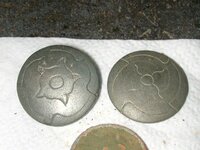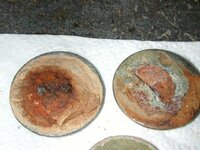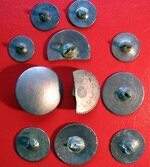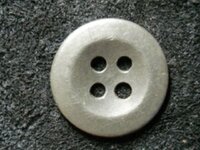Hello,
Found these two buttons about 20ft apart from each other at an 1840's farmstead near Colecamp, MO. They appear to have Pewter fronts, are approx. the diameter of a nickel, are very heavy for their size, and are identical in size and shape, except for having slightly different patterns on the faces.
Any help would be greatly appreciated.
Regards,
Jules
Found these two buttons about 20ft apart from each other at an 1840's farmstead near Colecamp, MO. They appear to have Pewter fronts, are approx. the diameter of a nickel, are very heavy for their size, and are identical in size and shape, except for having slightly different patterns on the faces.
Any help would be greatly appreciated.
Regards,
Jules




 I didn't know they existed until I found one yesterday at a site that ranges from 1780-1812.
I didn't know they existed until I found one yesterday at a site that ranges from 1780-1812.




